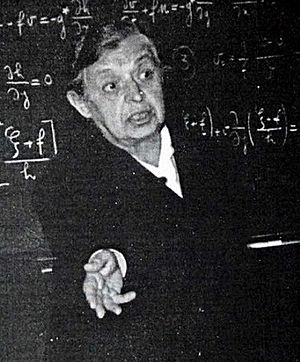Giuseppina Aliverti facts for kids
Quick facts for kids
Giuseppina Aliverti
|
|
|---|---|

Professor Aliverti
|
|
| Born | 4 December 1894 Somma Lombardo, Kingdom of Italy
|
| Died | 10 June 1982 Naples, Italy
|
| Nationality | Italian |
| Alma mater | University of Turin |
| Occupation | geophysicist |
| Known for | Aliverti-Lovera method of measuring the radioactivity of water |
Giuseppina Aliverti (1894–1982) was an amazing Italian scientist. She was a geophysicist, which means she studied the Earth's physical processes. She worked on many different areas of Earth physics. She is especially remembered for creating a special way to measure the radioactivity of water. This method is known as the Aliverti-Lovera method.
Contents
Her Early Life and Education
Giuseppina Aliverti was born in Somma Lombardo, Italy, on December 4, 1894. She had a sister named Teresa, and they were very close. Giuseppina was a brilliant student. In 1919, she graduated with top honors in physics from the University of Turin.
Her Teaching and Research Career
From 1932 to 1935, Giuseppina taught geodesy and geophysics in Turin. Geodesy is the science of measuring and understanding Earth's shape and gravity. After that, from 1936 to 1951, she taught terrestrial physics. This field studies the physical properties of the Earth.
In 1937, Giuseppina won a big competition held by the Italian government. Because she had the best scores in geophysics, she became the director of the Geophysical Observatory in Pavia. At the same time, she also taught terrestrial physics at the University of Pavia.
In 1949, Aliverti moved to Naples. There, she continued her teaching at the Naval University Institute. Today, this school is called the Parthenope University. She led the department of meteorology (the study of weather) and oceanography (the study of oceans). From 1960 until her retirement in 1970, she was the dean of the nautical sciences faculty. Giuseppina Aliverti passed away in Naples on June 10, 1982.
Discovering Water's Radioactivity
Giuseppina Aliverti's official research began in 1920. She first studied how electrolytic deposits (materials left behind by electricity) gather. She then expanded her work into terrestrial physics. She started experiments on electricity and the natural radioactivity in the air. In 1937, her work earned her a special ten-year prize for geophysical studies.
She worked with another physicist named Giuseppe Lovera. Together, they created a method to calculate the radioactivity of water. This is the famous Aliverti-Lovera method. Her research showed how much radioactivity helps to ionize the air. Ionization is when atoms gain or lose electrons, becoming electrically charged.
She found that air near land always has radon gas and its decay products. Sometimes, it even has thorium, another radioactive element. However, she found very little radioactivity in the air over the sea.
Exploring the Oceans
Later, Giuseppina Aliverti worked with Giuseppe Lovera again. They made important progress in studying marine aerosols. These are tiny particles in the air over the ocean. Because she was part of a special oceanography group for Italy's National Research Council (CNR), she planned five scientific trips. These trips explored the Tyrrhenian Sea between 1958 and 1960.
The information collected on these trips helped scientists figure out how much water evaporates from this sea each year. This work also led to future studies in the Strait of Gibraltar (in 1961) and more research in the Tyrrhenian Sea (in 1963).
Other Cool Science Projects
Even though she loved studying the oceans, Giuseppina Aliverti also kept studying other topics. She continued to research atmospheric electricity and glaciology (the study of glaciers) until her later years. She worked with researchers from the University of Turin in the Aosta Valley.
She also studied mountains using mathematics with a mathematical physicist named Carlo Somigliana. She was especially interested in the Lys glacier on Monte Rosa.
A Special Tool for Cosmic Rays
The Archiepiscopal Seminary of Milan had its own Earth physics observatory. This observatory used a special tool called the Aliverti-Lovera cosmic ray tool. This tool measured cosmic radiation, which are high-energy particles from space.
The observatory studied weather, earthquakes (seismology), atmospheric electricity, radioactivity, and cosmic radiation. The Aliverti-Lovera tool was built by famous technicians. It used a Wulf electrometer and four ionization chambers. These were the best and most modern tools for measuring radioactivity and cosmic rays at that time.
Important Groups She Joined
Giuseppina Aliverti was a member of several important scientific groups:
- Member of the Pontaniana Academy of Naples (1958)
- Corresponding member of the National Academy of the Lincei (1964)
- Corresponding member of the Lombard Institute's Academy of Sciences and Letters of Milan (1969)
Awards and Recognition
Giuseppina Aliverti received many honors for her contributions to science:
- Gold Medal of Merit of School, Culture and Art (1963)
- Grand Officer of Merit of the Italian Republic (1971)
- Gold Medal of the Faculty of Nautical Sciences of the Naval University of Naples (1971)

